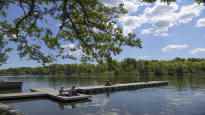Melanoma is estimated to increase for another couple of decades. Dermatologists are worried about it. Up to nine out of ten melanoma cases could be prevented with proper protection from the sun.
The shortness of the summer does not prevent the Nordic countries from reaching high places in melanoma statistics.
The top spot in the 2020 statistics is held by Australia, where melanoma occurs so much that it is called Australia’s national cancer, says BBC (switch to another service). According to it, melanoma is the most common cancer among 20-39 year olds in Australia.
The statistics for 2020 are still partially based on the forecast, but the Nordic countries are not in the top ten for the first time.
Hundreds of skin cancers may have gone undiagnosed
Among the Nordic countries, Denmark’s incidence curve has been on the steepest rise in the 2000s. The incidence in Sweden, Norway and Finland has also increased throughout the beginning of the century.
Only Iceland is missing from the Nordic countries in the top ten of the 2020 statistics. The situation there was at its worst at the end of the last century; the increase was explained not only by foreign tourism, but also by an increase in the use of solariums.
The American Journal of Epidemiology called Iceland’s situation in his article (you will go to another service) into a melanoma epidemic. However, the trend was reversed, and now Iceland is the only one in the Nordic countries where the incidence of melanoma is decreasing in both men and women.
Melanoma was diagnosed in 2020 by the director of the Finnish Cancer Registry, professor Nea Malilan including 826 Finnish men and 717 women, while the average number of cases has been just under 2,000 each year.
In Finland, according to cancer organizations, hundreds of skin cancers could go undiagnosed in 2020, because the corona pandemic stopped seeking treatment.
Melanoma is the most dangerous skin cancer. Basal cell cancer, for example, occurs many times more than that, but if it is of good quality, it can be treated by removal almost 100% of the time, and only one tumor per person is recorded in Finland. The growth of squamous cell cancer has slowed down in Finland and is more moderate than that of melanoma.
Skin type and tanning sweat don’t match
The weather conditions in Australia and the Nordic countries can hardly be equated, but otherwise there are common explanations: skin type and at least part of the beauty ideal.
For example, 63 percent of the respondents to a survey conducted by Finnish cancer organizations in the spring say that tanned skin looks good and more than half tan themselves at least sometimes.
In Australia, a large proportion of the inhabitants are light-skinned immigrants who cannot withstand the sun’s ultraviolet radiation or their descendants.
In Sweden, the radiation safety center there warned last summer (you switch to another service)that the country’s skin cancer rates may increase to the level of Australia, if information about UV radiation and its risks is not managed to reach a country with a lot of light-skinned people who are sensitive to radiation.
The majority of American dermatologists are located in Finland of Thomas B. Fitzpatrick into the three most sensitive groups of the skin type classification.
– It is strange how the incidence has increased even in Finland, even though the skin type and conditions in the sun are mostly unchanged. The skyrocketing rise in melanoma in the 21st century must be due to previous incorrect sunbathing, i.e. letting the skin burn, says Professor Nea Malila, director of the Finnish Cancer Registry.
It is especially harmful to children.
The previous peak was in the 1970s and 1980s, when the rise in the standard of living started to boost foreign tourism.
However, the earlier diagnosis of melanoma and the relaxation of the criteria in Finland can partly explain the statistics, Malila reminds. Cases that are milder than before are diagnosed as melanoma, in which case they are also more treatable.
It can also be seen in the forecasts: now 94 percent of melanoma sufferers are alive five years after diagnosis, compared to only 35 percent in the 1960s.
New generations must be warned about UV radiation
So what would stop the development?
In Australia, work has been done for a long time to reduce melanoma, that is, to highlight the dangers of UV radiation. The campaign Slip, slop and slap, which encourages people to protect themselves with a shirt, hat and sunscreen, started already in the 1980s and has brought about a positive development.
The country has also developed a UV warning system and, for example, stickers that can be placed on the back of the hand, which notify when the protective effect of the sunscreen fades.
Phil Barker However, the University of Wollongong in Australia tells the BBC that the message needs to be constantly reinforced and new generations educated. This is also indicated by the fact that in the summer of 2018-2019 more people with sunburns were treated in the emergency departments of the state of Victoria than at any time since 2004. There were many children in the group.
Although the current generations have more information than the previous ones, the turnaround will not happen in an instant. The more radiation and skin burns a person has experienced, the greater the risk of developing melanoma with age, reminds Professor Nea Malila, director of the Finnish Cancer Registry.
The carefree sunbathing of previous decades can therefore redden the statistics for a long time before a change for the better.
